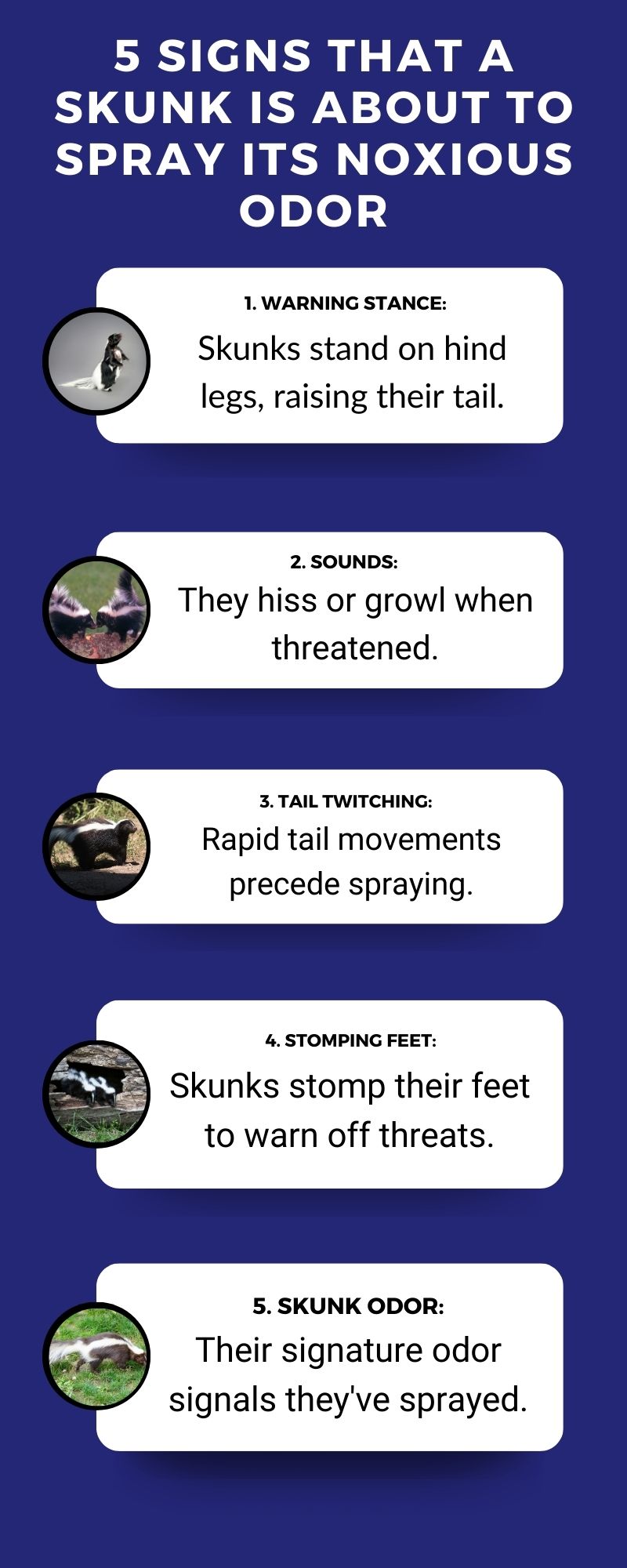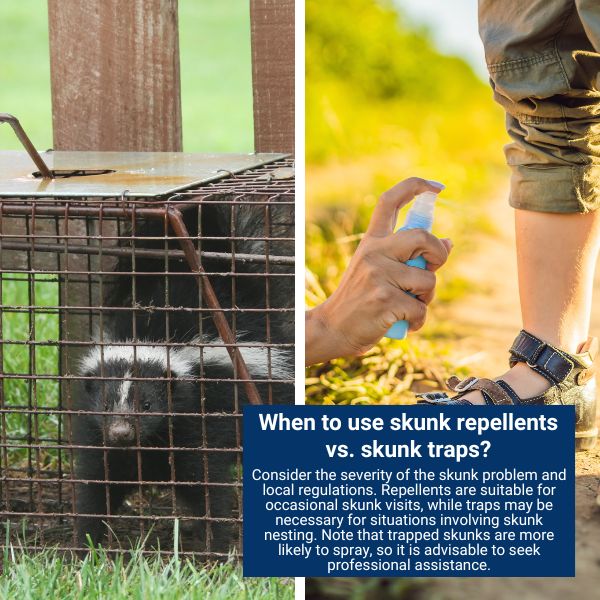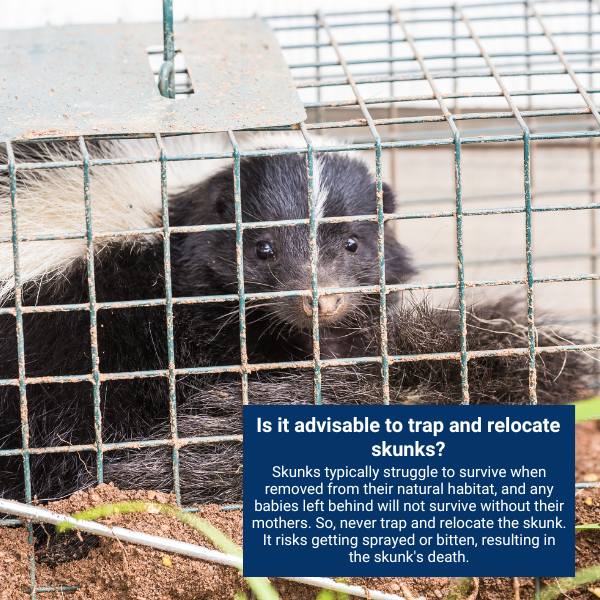Intrusion, destruction, and that dreadful, unmistakable smell – skunks under your deck are an unwelcome surprise that can turn your outdoor space into an olfactory nightmare. Many homeowners shudder at the thought of encountering these infamous black and white creatures in their backyard and for good reason.
From their off-putting odor to the potential for property damage, skunks pose several challenges. If you’re a deck owner grappling with this issue, you’re probably asking the same question – how do you effectively get rid of skunks under your deck?
To remove skunks under your deck, find entry points and block with wire mesh. However, if they are in there, use bright lights, natural deterrents, and loud noises or sprinklers to scare them. Trapping with professional help is an option. Leave dens undisturbed in winter, and fill holes when babies are older.
Hence, this comprehensive guide will equip you with a set of humane skunk removal tactics and give you the tools you need to reclaim your outdoor space from these odorous invaders. From identifying skunk entry points to utilizing natural deterrents, I’m here to guide you on reclaiming your deck. Let’s dive in.
8 Best Ways To Send Off Skunks Under Your Deck Forever
Skunks, while possibly charming in appearance, are truly troublesome pests that you’ll want to discourage from your property as soon as possible. Aside from the infamous eye-watering odor they can emit, skunks are also known for their destructive tendencies and aggressive behavior.
These creatures are avid diggers, often burrowing into your yard and garden to gain access under your deck. Here, they establish dens, potentially producing a new generation of skunks to further invade your outdoor space.
Discovering a skunk under your deck requires immediate action. These creatures favor shadowy, damp environments, and their infamous defensive spray adds complexity to their removal. Surprisingly, the tactics to encourage their departure may not be what you’d first expect, but prompt and careful measures are crucial.

So, what’s the game plan when a skunk chooses your deck as their ideal residence? After thorough research and delving into expert recommendations, I’ve compiled an array of strategies to deal with this situation effectively.
Here’s how you can not only evict them but also ensure they won’t consider your deck their home again.
1. Identify Entry Points And Block Them
The first step in tackling the skunk problem is identifying their entry points. Carefully observe their movements and look for gaps or openings that may be used to access your deck.
After spotting these gateways, it’s time to put up some barricades. A reliable way to do this is by employing Heavy Gauge Galvanized Hardware Cloth, which you should firmly secure to prevent any skunk from sneaking through.
When skunk-proofing your property, quality matters. Opt for heavy gauge galvanized hardware cloth for lasting and effective results. Reinforce any openings with sturdy materials like wire mesh, sheet metal, or concrete.
To deter skunks from burrowing, the fence or hardware cloth should be buried at least 2 inches into the ground. For an extra layer of defense, bend the mesh at a 90-degree angle and extend it at least 12 inches outward from your deck or structure.
Consider Your Soil Type: If your property has loose or sandy soil, you might need to increase the depth and length of the mesh. For those in colder climates, where skunks are more motivated to find shelter, burying the mesh deeper could be beneficial.
Moreover, Skunks are drawn to areas that offer good coverage, such as piles of wood, rocks, or debris. By removing these potential hideouts, you’ll make your property less attractive to foraging skunks.
Window wells can also provide an easy entry for skunks. Protect them with plastic or metal mesh covers. Finally, Check beneath porches and outbuildings, as these spots can often become skunk dens.
Thus, by denying them access, you eliminate the opportunity for skunks to settle under your deck!
2. Remove Attractants
Skunks are attracted to food sources, so it’s vital to eliminate any temptations in your yard. Ensure your trash cans have tight-fitting lids, preventing skunks from scavenging for food. Remove any fallen fruits, nuts, or bird feeders that might attract skunks.
3. Opt For Commercial Skunk Repellents and Home Remedies
When it comes to keeping skunks at bay, various options are available, ranging from commercial skunk repellents to DIY home remedies. Many such solutions utilize natural ingredients that are safe for humans, pets, and the environment. These include peppermint essential oil, putrescent egg whites, dried blood, garlic oil, black pepper, and urine from skunk predators like coyotes.
When selecting the best skunk repellent for your situation, it’s essential to consider a few factors.
Types Of Skunk Repellents
Skunk repellents typically come in three main types: spray, granular, and electronic.
Spray repellents are liquid-based and require frequent reapplication, while granule repellents offer longer-lasting protection. Electronic repellents use motion detectors and emit high-pitched sounds to scare skunks away, but they may irritate pets and potentially provoke a skunk spray.
How do Skunk Repellents Work?
Weather conditions play a role in the effectiveness of skunk repellents. Spray repellents may wash off in the rain, while granules are more durable. Electronic repellents are waterproof but require sunlight to charge their batteries.
Here is a list of the most common Home Remedies to consider:

- Ammonia Power
Skunks have a highly sensitive sense of smell, and the harsh odor of ammonia can deter them from settling in your deck area. To use this method, soak rags or cotton balls in ammonia and place them near the entrance of the skunk’s den or underneath your porch.
Skunks find the smell repulsive and will likely avoid those areas. If the ammonia scent is too strong for you, consider placing the soaked materials in a plastic bag before positioning them.
- Apple Cider Vinegar Trick
Similar to ammonia, the strong odor of apple cider vinegar can discourage skunks from staying under your deck. Soak rags or cotton balls in apple cider vinegar and put them in a plastic bag.
Position the bag under your porch, shed, or near the entrance of the skunk’s den. The scent of the vinegar will send them away while stopping them from returning to those areas.
- Citrus Peel Scatter
Skunks have an aversion to citrus scents, making citrus peels an effective natural repellent. Scatter lemon or orange peels under your deck or porch, as skunks find the smell unpleasant.
Alternatively, cut up the peels and spread them around your property. The citrus scent will discourage skunks from venturing near your deck and keep your environment fresh.
- Predator Urine – A Natural Deterrent
Spread Predator Urine! Skunks are wary of the scent of natural predators like foxes and dogs. You can utilize this instinct by spreading predator urine around the den or yard. If you have a dog, encourage it to urinate near the skunk’s den or in areas where skunks frequent. Thus, discouraging them from staying in those locations.

4. Using Skunk-Repelling Plants
Adding plants that naturally deter skunks is a brilliant and visually pleasing solution to your skunk issue. These are plants that are either too potent, thorny or even toxic for skunks to tolerate, thus keeping them at bay. Here are a few you might consider planting:
- Peppermint: Its potent aroma acts as an ideal skunk repellent. Beware, it spreads quickly.
- Crown Imperial (Fritillaria imperialis): Deters skunks with its strong scent and visually striking flower arrangement. Tolerates drought after initial watering.
- Bougainvillea: A natural skunk barrier due to its sharp thorns.
- Summer Squash: Discourages skunks with its prickly leaves. Great for vegetable gardens.
- Stinging Nettle: Its irritating hairs keep skunks at bay.
- Oregon Grape: The thorny leaves and skunk predator-attracting fruit effectively deter skunks.
- Lavender: Adored by humans, its scent repels skunks.
- Daffodil: Its toxic bulbs serve as an effective skunk deterrent.
Note: All these plants have diverse sunlight and watering needs. Most flourish in well-drained soil and require regular watering. Sunlight needs range from full sun exposure to partial shade. Some, like the Bougainvillea, require shade in hot summers, while others, such as Peppermint and Lavender, need good sun exposure. Always consider a plant’s specific requirements for optimal growth.

5. Shed Some Light:
Skunks are nocturnal creatures and prefer dark, quiet environments. Installing predator deterrent lights or motion-activated light systems in your yard creates a less appealing environment for skunks.
These lights illuminate the area when skunks approach, startling them and encouraging them to seek shelter elsewhere. Solar-powered lights are an excellent energy-saving option for this purpose.
6. Creating Noise Disturbances
Skunks are nocturnal creatures that favor serene environments. Their sensitive hearing and preference for quiet make them susceptible to noise disturbances. You can use this to your advantage by strategically placing a radio or set of loudspeakers near identified skunk territories like dens or beneath decks.
Opt for talk radio or loud music, which can create a cacophony of human voices or noises unfamiliar to skunks. Make sure to play this noise mainly during the night when skunks are most active. The constant auditory disruptions will create an inhospitable environment for these peace-loving animals, encouraging them to seek out a more tranquil habitat.
7. Installing Motion-Activated Sprinklers
Skunks, much like cats, have an aversion to water, particularly sudden bursts of it. To exploit this dislike, consider installing motion-activated sprinklers near suspected skunk activity areas.
These ingenious devices work by detecting motion (like an approaching skunk) and responding by triggering a sudden spray of water. Place these sprinklers strategically near the entrances of skunk dens or around perimeters you wish to protect, such as your deck.
This will ensure that any approaching skunk gets an unexpected and unpleasant surprise. The startling bursts of water not only serve to scare away the skunk momentarily but, over time, the intermittent sprays act as a strong deterrent.
Note: Purchase motion-activated sprinklers designed for wildlife deterrence with adjustable sensitivity and range settings.
8. Professional Wildlife Removal
If all else fails or you’re uncomfortable dealing with skunks alone, it’s best to seek professional assistance. A wildlife removal service has the expertise and experience to safely and humanely remove skunks from under your deck. They will follow local regulations and employ the most appropriate methods to relocate the skunks to a more suitable habitat.

What To Do If Skunk Babies Are Under Your Deck?
Skunks usually find shelters when they are about to lay babies. I suggest leaving skunk dens undisturbed during winter and waiting for warm weather if newborns are present. When the babies are old enough to follow the mother, fill the den hole to prevent re-entry.
Still, if you want to remove them immediately, use any method I have explained in this blog post. Besides, in the case of babies, it is better to seek professional assistance to avoid provoking skunks. Use exclusion techniques to prevent future denning.
Final Words!
Skunks can take refuge under your deck, shed, or home, especially during winter or when raising their young. Dealing with them requires a combination of prevention, deterrents, and, when necessary, professional assistance.
As a pro tip, consider taking preventive measures to skunk-proof your deck by installing barriers before an infestation occurs. Regularly inspecting and maintaining your property can help you detect and address any potential entry points early on.
By following practical steps and tips, you can effectively address the skunk issue and create a skunk-free environment, allowing you to enjoy your outdoor space without any unwanted surprises.

